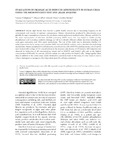Mostrar o rexistro simple do ítem
Evaluation of Okadaic Acid-Induced Genotoxicity in Human Cells Using the Micronucleus Test and γH2AX Analysis
| dc.contributor.author | Valdiglesias, Vanessa | |
| dc.contributor.author | Laffon, Blanca | |
| dc.contributor.author | Pásaro, Eduardo | |
| dc.contributor.author | Méndez, Josefina | |
| dc.date.accessioned | 2024-01-11T20:10:08Z | |
| dc.date.available | 2024-01-11T20:10:08Z | |
| dc.date.issued | 2011-06-27 | |
| dc.identifier.citation | Vanessa Valdiglesias, Blanca Laffon, Eduardo Pásaro & Josefina Méndez (2011) Evaluation of Okadaic Acid-Induced Genotoxicity in Human Cells Using the Micronucleus Test and γH2AX Analysis, Journal of Toxicology and Environmental Health, Part A, 74:15-16, 980-992, DOI: 10.1080/15287394.2011.582026 | es_ES |
| dc.identifier.issn | 1087-2620 | |
| dc.identifier.uri | http://hdl.handle.net/2183/34848 | |
| dc.description | This is an Accepted Manuscript version of the article, accepted for publication in Journal of Toxicology and Environmental Health, Part A. | es_ES |
| dc.description.abstract | [Abstract] Marine algal blooms have become a public health concern due to increasing frequency in the environment and severity of exposure consequences. Human intoxications produced by phycotoxins occur globally through consumption of marine fish products containing bioaccumulated toxins. Okadaic acid (OA) is the main representative of diarrheic shellfish poisoning (DSP) toxin. OA was found to inhibit protein phosphatases and to produce oxidative damage, as well as to disturb different cellular functions including cell cycle, gene expression, and DNA repair mechanisms. The aim of this study was to determine whether OA induced genotoxicity by using a micronucleus (MN) test and γH2AX analysis, and to elucidate the underlying mechanisms. Human peripheral blood leukocytes, neuroblastoma cells (SHSY5Y), and hepatoma cells (HepG2) were treated with a range of OA concentrations in the presence and absence of S9 fraction. MN induction was observed in leukocytes at all concentrations tested, and in SHSY5Y and HepG2 cells only at the highest concentration (1000 nM). In contrast, γH2AX analysis was only positive for HepG2 cells. Taking together these data, in addition to the comet assay results obtained in a previous study in this issue, OA was found to exert a either a clastogenic or aneugenic effect dependent upon the cell types examined. | es_ES |
| dc.description.sponsorship | This work was funded by a grant from the Xunta de Galicia (INCITE08PXIB106155PR). V. Valdiglesias was supported by a fellowship from the University of A Coruña | es_ES |
| dc.description.sponsorship | Galicia. Xunta; INCITE08PXIB106155PR | es_ES |
| dc.language.iso | eng | es_ES |
| dc.publisher | Taylor and Francis | es_ES |
| dc.relation.uri | https://doi.org/10.1080/15287394.2011.582026 | es_ES |
| dc.rights | Atribución-NoComercial 4.0 Internacional | es_ES |
| dc.rights.uri | http://creativecommons.org/licenses/by-nc/4.0/ | * |
| dc.title | Evaluation of Okadaic Acid-Induced Genotoxicity in Human Cells Using the Micronucleus Test and γH2AX Analysis | es_ES |
| dc.type | info:eu-repo/semantics/article | es_ES |
| dc.rights.access | info:eu-repo/semantics/openAccess | es_ES |
| UDC.journalTitle | Journal of Toxicology and Environmental Health. Part A, Current Issues | es_ES |
| UDC.volume | 74 (2011) | es_ES |
| UDC.issue | 15-16 | es_ES |
| UDC.startPage | 980 | es_ES |
| UDC.endPage | 992 | es_ES |
| dc.identifier.doi | 10.1080/15287394.2011.582026 |






